Timeline
1910
Disastrous
industrial
fire.
In
mid
February
a
fire
in
St
Ann's
Road
would
cause
great
destruction.
William
Sharpe's
builder's
merchants
filled
with
wood,
paint
and
other
materials
that
would
feed
a
fire
nicely,
erupted,
taking
with
it
a
large
warehouse
and
shop.
Surrounding
the
site
are
tightly-
knit
terraced
housing
which
created
great
concern
for
the
residents
who
tried
to
barricade
their
properties
from
the
raging
fires
and
evacuated
inhabitants
and
removed
anything
of
value.
Crowds
started
to
build
which
caused
problems
for
the
fire
service
to
access
the
fire.
The
large
building destroyed ran between Maldon Road and St Ann's Road.
Sacred
Heart
opens.
A
new
catholic
church
on
Southchurch
Road
formerly
opened
this
year,
a
large
and
distinguished
assembly
of
catholic
clergy
were
in
attendance
led
by
His
Grace
the
Archbishop of Westminster. Father Norgate would conduct the mission at the church.
Leigh
Regatta
is
born.
Emulating
successful
regattas
in
Southend
and
using
the
event
as
away
to
boost
business
through
tourism
Leigh
Regatta
was
born.
Full
of
water
based
events
such
as
sailing,
rowing,
sculling
and
swimming
races,
not
forgetting
the
legendary
greasy
pole
and
fireworks
in
the
evening.
The
Regatta
was
abandoned
due
to
the
start
of
the
Second
World
War,
but
was
relaunched
in the 70's, and enjoyed still today.
Violent
storms
hit
the
area
in
1910,
and
particularly
affected
the
junction
at
the
Cricketer's
pub
in Westcliff, a prime flooding point at any time, even still today.
Empire
opens
in
Leigh.
The
Empire
Palace
opened
on
3rd
December
1910,
with
a
very
keen
audience
waiting
to
watch
the
first
show
'The
Heads
of
the
World'.
The
building
was
located
behind
the
Grand
Hotel.
The
site
including
Overtons
next
door
was
demolished
in
January
2009.
R.
A.
Jones
gift.
In
March
1910,
the
new
tramways
ticket
office
in
Victoria
Circus
became
the
recipient
of
a
gift
from
R.
A.
Jones
in
the
shape
of
a
clock
placed
in
the
central
turret
on
behalf
of
the Corporation.
Job
Centre
arrives.
The
very
first
Employment
Exchanges
came
into
existence
in
the
UK
in
1910.
Southend's
need
to
solve
unemployment
was
demonstrated
when
it
received
one
of
the
first
Employment
Exchanges
in
the
February
of
the
same
year,
initially
they
would
assist
with
the
filling
of
vacancies
for
building
and
engineering
trades,
but
as
the
war
advanced
in
1914
they
became
essential towards recruiting for the armed forces.
Anyone
for
bowls.
The
Borough
was
becoming
popular
for
the
sport
of
bowls
and
this
was
underlined with the forming of the Southend Bowls Club in Victoria Avenue in 1910.
To
Thorpe
Bay
by
train.
The
summer
of
1910
saw
the
opening
of
another
rail
station
2
miles
east
of
Southend
Central.
On
1st
July,
Thorpe
Bay
saw
passengers
arriving
and
departing
on
the
LTS
line.
the
station
for
a
matter
of
days
took
the
title
of
Southchurch
Station,
but
was
re-branded
courtesy
of
Colonel
Burges's
Thorpe
Hall
Estate.
The
area
around
at
this
time
was
still
quite
rural and begged for advanced development, time would not disappoint.
The
Roots
of
flight.
July
1910
proved
to
be
an
exciting
time
for
the
town
as
some
2,000
people
gathered
at
Roots
Hall,
not
to
watch
football
as
the
stadium
did
not
exist
then,
but
at
this
time
the
fields
that
covered
this
area
became
the
perfect
site
for
what
was
thought
to
be
the
first
powered
flight
in
the
town.
George
Barnes
the
pilot
covered
some
50
yards
leaving
the
ground
high
enough
to
clear
a
fence.
Little
did
he
know
that
this
first
flight
in
front
of
large
crowds
would
not
be
the
last
with
the
air
show
being
a
future
mass attraction.
More
church
building.
1910
was
a
good
year
for
church
building
the
foundations
for
Crowstone
Congregational
Church
were
laid.
On
24th September solemn Masonic rites marked the stone-laying of St Saviour's, Westcliff.
St
Bernard's
Girls
Catholic
School
opened.
Located
in
Milton
Road,
St
Bernard's
Girls
Catholic
School
in
1910
opened
it's
doors.
St
Bernard's
became
established
and
opened
with
a
compliment
of
120
day
girls
and
five
lay
teachers
on
29th
September
1910.
At
the
time
there
probably
seemed
to
be
lots
of
room
to
expand
for
the
future,
in
reality
today,
with
the
spread
of
the
this
south
Westcliff
area,
they
have
reached
a
point
where
the
only
way
to
grow
would
be
upwards
or
maybe
downwards.
The
school
is
noted
for
one
of
it's
former
girls,
Dame
Helen
Mirren
who
lived
in
Westcliff
and
still
returns on occasion for prize giving ceremonies.
St
Erkenwalds's
Church
second
phase
constructed.
A
famous
church
built
on
the
junction
of
York
Road
and
Southchurch
Avenue.
A
'Marmite'
style
of
architecture
very
bold
design,
that
was
loved
or
hated.
It
fell
foul
to
a
huge
fire
in
the
latter
part
of
it's
life
when
in
a
sate
of
dereliction;
so
its
final
demise was not difficult to predict in 1995.
Southend's
first
female
Councillor.
The
times
were
a
changing
when
Westborough
Ward
elected
the
Borough's
first
female
Councillor. Miss Bannester was the Principal of Alexandra College.
Panto
time.
This
year's
festive
theatrical
treat
would
lie
in
the
hands
of
Aladdin
at
the
town's
key
venue
the
Empire
Theatre.
The
production
was
of
exceptional
merit
and
drew
large
audiences.
Messrs.
Glenville
and
Osmond's
Company
was
one
of
the
best
that
ever
visited
Southend,
and
the
piece
was
mounted
and
dressed
with
exceptional
brilliancy.
The
cast
was
a
strong
one,
including
Miss
Hettie Zillwood as "Aladdin," Mr Tom E Sinclair as "Abanazar," and Mr Clarence Turner as "The Widow Twankey."
1914
The Mission church of Little St. Francis, in Stornoway Road, was opened.
April. Woolworths opened at 29 High Street.
28th July. World War I starts.
Southend Corporation’s new loading pier is completed opposite the gasworks, cost £10,878.
Sickness
in
Southend.
November
1914.
Scarlet
Fever
22,
Diptheria
10,
Typhoid
Fever
9,
Puerperal
Fever
2,
Erysipelas
1,
Opthalmia
Neonatonum 1.
Royal
visit.
In
June
Queen
Mary
visited
the
now
requisitioned
property
the
Queen
Mary's
Naval
Hospital,
something
to
be
repeated
a
couple
of
years
later.
The
property
in
question
would
be
now
recognised
as
the
Palace
Hotel.
A
perfect
location
based
above
the
pier that would transit the injured during war straight to the care of the medical profession.
War
starts,
Pier
pressed
into
action.
Southend
Pier
has
a
long
and
largely
unrecognised
military
service
in
both
of
the
World
Wars.
During
the
Great
War
in
November
1914
prisoner
of
war
ships
were
moored
in
the
estuary,
the
Royal
Edward,
the
Invernia
and
the
Saxonia.
The
pier
saw
the
regular
arrival
of
German
prisoners
to
be
transported
to
ships
moored
off
the
Pier,
including
many
Barons
and
other
titled
Germans.
All
3
ships
were
removed
from
this
service
in
the
Spring
of
1915.
The
Royal
Edward
and
the
Invernia
were
torpedoed during this conflict while the Saxonia had a longer life and finally scrapped.
August
1914,
after
having
a
refit
and
modifications
for
expedition
purposes
at
Millwall
Dock,
London,
the
three-masted
barquentine
called
the
‘Endurance’
(formerly
‘Polaris’)
owned
by
the
Antarctic
Explorer
Sir
Ernest
Shackleton
dropped
anchor
just
off
Southend
near
the
Pier
for
a
short
period,
she
was
en
route
to
Plymouth.
Endurance
sailed
from
Plymouth
on
6th
August
1914
and
set
course
for
Buenos
Aires,
Argentina,
under
the
ships
captain
Frank
Worsley’s
command.
On
26th
October
1914
the
Endurance
with
expedition
leader
Sir
Ernest
Shackleton
and
a
crew
of
28
men,
five
sled
dogs
and
one
cat
sailed
for
the
Antarctic
on
the
1914–1917
Imperial
Trans-Antarctic
Expedition.
The
Endurance
would
later
get
stuck
in
pack
ice
and
would
finally
sink
in
November
1915.
The
crew survived but Shackleton decided that Mrs Chippy the ship’s cat and the five sled dogs would not survive and were shot dead.
Southend
powered
by
the
Germans.
Late
in
1914
the
British
Government
commandeered
five
new
diesel-engine
driven
generating
sets
installing
them
to
power
up
Southend.
This
however,
would
still
leave
the
town
short
for
it's
customer
demand.
Using
ingenuity
and
subtly
altering
the
use
for
land,
the
Town
Council
purchased
six
complete
diesel
engines
which
would
have
run
German
Submarines
conveniently
surrendered
at
the
time.
These
were
distributed
around
the
town
into
two
sub
stations
and
the
main
power
plant.
Southend-on-Sea Constabulary is formed, Separate from the Essex Constabulary. Although this decision was reversed in 1969.
The
Pest
House
is
demolished.
Before
the
amazing
advancements
of
modern
medicine
most
built
up
towns
had
a
'pest'
house
located
away
from
the
main
populace.
Southend
was
no
exception
and
had
its
Pest
House
around
the
site
of
the
Albany
Laundry
not
far
from
the
Cavendish
Gardens/Kingsway.
Although
it
had
not
been
used
for
many
years
as
a
refuge
for
those
suffering
the
incurable
diseases, it was finally disposed of in 1914.
Leigh
gets
another
cinema.
Probably
the
most
popular
of
all
the
Leigh
cinema's
was
the
Coliseum
opening
in
April
1914
in
Elm
Road.
Designed
to
impress
with
a
barrel
ceiling
decorated
gold
and
red
and
seating
an
audience
of
600
in
plush
seating,
this
was
to
increase to 1100. The cinema had a longer life than most in the borough finally succumbing to Bingo in 1965.
Troops
take
over
the
parks.
The
war
made
Southend
a
natural
base
for
many
troops
who
took
up
station
in
the
area,
this
brought
about
some
interesting
demands,
one
of
which
included
the
request
to
use
the
parks
for
the
purposes
of
parades
and
drill,
thereby
maintaining
discipline
within
the
ranks.
Colonel
Patton-Bethanal
Officer
Commanding
14th
Rifle
Brigade
was
given
permission
to
this very thing in Southchurch Park as long as they did not in the course of their drilling go on to the much hallowed cricket pitch.
All
Saints
Ward.
Named
after
All
Saints
Church
on
Sutton
Road,
was
incorporated
in
1914,
and
grew
up
around
Porters
Town.
It
would include the first housing estate in Southend in Ruskin Road, as well as the Victoria Rail Station and the Stadium.
Most of the Royal Library on Pier Hill is demolished.
Thorpe Hall Boulevard open to trams.
Westcliff
Police
Station
expands.
As
the
town
expanded
so
did
the
need
for
the
support
services.
Permission
was
given
to
purchase
land
in
Claremont
Road
to
expand
Westcliff
Police Station on the junction with West Road.
Telephone
use
growing.
By
1914
the
number
of
telephones
across
the
town
had
reached
a
total
of
684
lines.
With
the
outbreak
of
the
war
and
through
it
the
number
would
slightly
increase and decrease.
Southend gains status. An important date in Southend's development being bestowed County Borough status on 1st April 1914.
Penny Bazaar opens in the High Street the site will later become Marks & Spencers.
1913
The
Shoebury
Palace
opens.
Shoebury
would
get
its
very
own
cinema
on
10th
May
1913
in
Ness
Road
and
prove
very
popular
to
the
troops
based
at
the
garrison.
Unusual
for
the
time
the
cinema
was
built
with
a
balcony,
it
received
some
modernisation
during
the
40s.
The
cinema
in
comparison
to
others
across
the
Borough
had
a
short
life
closing
on
5th
March
1955,
forced
to
close
due
to
the
sharp
decline
in
audiences
due
to
the
pressure
of
alternative
forms
of
entertainment
including
TV
although
in
its
infancy
still
had
an
impact.
The
building
is
one
of
the
key
buildings
in
Shoebury
that
is
appreciated
by
the
elder
generations
that
still
remember
it
for
its
original
purpose.
The
site
due
for
development
received
listed
status
protecting
the
façade in April 2009.
Old
PO
gone.
The
Old
Post
Office
in
Southchurch
is
demolished
to
make
way
for
the
boulevard. This building sat close to where the White Horse/Old Walnut Tree pub is now.
The
girls
move
out.
Southend
High
School
for
Girls
moves
to
new
premises
in
Boston
Avenue,
from
the
large
joint
school
in
Victoria
Circus.
The
new
school
was
erected
at
a
cost
of
over
£20,000,
including
the
site.
Opened
with
a
compliment
of
300
pupils
under
the
Headship of Miss N. E. Lewis MA. To be succeeded in 1918 by Miss F. A. Swann BA.
Dixons
arrives
in
Vic
Circus.
One
of
the
most
famous
stores
to
grace
Southend's
High
Street:
Dixons
opens
for
the
first
time.
Surviving
in
the
spot
until
1973.
The
store
started
off
small
but
as
land
and
opportunity
arrived
so
it
expanded
to
be
a
substantial
department store. The site today is occupied by W. H. Smiths.
Kursaal
gets
Kinema.
Since
1904
the
Kursaal
had
been
showing
films,
in
1913
a
purpose
built
cinema
auditorium
was
opened
in
the
October.
The
cinema
closed
during
the
war
bit
reopened
not long after.
St
Augustine's
is
formed.
A
sign
of
the
extending
population
and
general
urban
spread
was
seen
with
the
addition
to
the
collection
of
Borough
churches
with
the
formation
of
St
Augustine's
in
Thorpe Bay in 1913. The permanent would be completed in 1935.
Ravens
in
Westcliff.
One
of
Southend's
longest
trading
retailers
expanded
into
the
then
much
respected
Hamlet
Court
Road,
the
business
was
owned
and
managed
by
Percy
Raven.
At
the
time
blossoming
as
a
centre
for
the
discerning
shopper.
Ravens
survives
strong
and
proud
in
the
town centre today.
Southend's
new
tram
boulevard.
A
tramway
extension
was
opened
in
August
this
year
between
Southchurch
Church
and
Bourne's
Green.
The
route
is
to
eventually
link
up
the
Thorpe
Bay
line,
the
whole
distance
was
formed
into
a
boulevard
planted
with
trees,
and
a
roadway
on
either
side
of
the
track.
At
the
time
it
was
considered
to
be
a
unique
design
and
nothing
like
it
could
be
seen
other than in Berlin.
13th
September.
West
Leigh
Schools
are
opened
by
the
Mayor
of
Southend,
Alderman
Francis
JP.
Leigh
joins
the
gang.
Leigh-on-Sea
on
the
9th
November
1913
boosted
Southend
Borough's
population
to
82,000
by
becoming
incorporated. Elements of independence rightly persisted and a Leigh Town Council was formed in 1996.
Pier
struck
by
barge.
The
barge
"Basseldon,"
laden
with
rubbish
for
use
in
connection
with
the
front
improvements,
parted
her
cable
in
the
gale
of
December
4th,
and
was
driven
on
the
piles
under
the
pier
breaking
four
of
them,
and
snapping
her
mast.
The
captain
and crew were saved by climbing onto the pier.
All
hail
the
Mascot.
Along
the
Leigh
(London)
Road
opened
a
new
picture
house
the
Mascot
to
the
public
on
Tuesday
23rd
December.
The
first
film
to
welcome
in
the
new
Westcliff
cinema
was
The
Duke's
Talisman.
The
cinema
itself
was
located
on
the
junction
with
Beedell
Avenue,
and
lasted
until
the
mid
60s
when
an
errant
firework
started
a
ferocious
fire
that
tore
the
building
down.
Panto
time.
The
Hippodrome
in
Southchurch
Road
had
really
become
the
home
in
Southend
for
the
annual
festive
treat.
This
year
Harry
Elliston
produced
Babes
in
the
Wood.
This
charming
rendition
combining
a
nursery
story
with
the
exploits
of
Robin
Hood
ensured
the
seats
were
full
for
the
period
the
panto
stayed.
Comedienne
Mabel
Osborn
took
the
main
lead
as
Robin
Hood,
she
sang,
acted
and
danced
with
charming
abandon.
She
was
supported
by
Winnie
Darrell
a
winsome
Maid
Marion.
As
with
every
panto
there
is
a
need
for
a
dame
and
this
role
was
ably
filled
by
Harry
Elliston,
who
managed
to
maintain
the
humour
throughout
the
production.
1912
April.
In
the
Titanic
disaster,
Mr.
Thomas
P.
Franklin
of
Ceylon
Road,
Westcliff
and
Mr.
Arthur
Lawrence
of
Rochford,
a
steward,
were drowned.
May. Official opening of the Leigh Council Offices.
August. Graham White and Messrs. Travers and Noel give exhibition flights in new seaplane on Western Esplanade.
Southend's
new
motor
fire
engine.
Southend
Town
Council
purchased
a
motorised
fire
engine
for
the
force,
ensuring
more
lives
and
buildings
will
be
saved
from
the
destruction
of
fire.
The
tender
would
arrive
at
the
end
of
January
and
is
of
the
celebrated
Merryweather
"Hatfield"
pattern,
as
already
in
use
in
other
major
cities
around
the
country.
Outside
Greater
London
it
will
be
the
first motorised engine in the county. The pump on this engine would be able to deliver 350 gallons a minute.
Jewish
faith
served.
Southend's
development
would
always
bring
with
it
the
need
to
accommodate
its
growing
diversity
too.
Therefore in February due to much demand a new Synagogue was opened on Alexandra Road.
The
Palace
Theatre
opens.
The
theatre
under
the
management
of
the
Raymond
Animated
Picture
Company,
opened
on
Monday
21
October
1912
and
named
as
the
"Palace
of
Varieties"
on
14th
November.
The
opening
ceremony
was
conducted
by
the
Deputy
Mayor,
Alderman
J.
C.
Ingram,
who
said
the
theatre
was
another
link
in
the
prosperity
of
the
Borough.
The
very
first
show
was
a
variety
night
which
included
the
skills
of
Mr
Arthur
Hill
who
appeared
as
the
human
marionette,
the
audience
did
enjoy
this
act,
he
continued
with
representations
of
"Robinson
Crusoe,"
and
a
sailor,
and
his
jests,
songs
and
dances.
Miss
Rosie
Archer
took
to
the
stage
with
a
favoured
performance
on
the
piano.
Then
followed
"the
Dandy
Doctor"
a
farcical
frolic
from
Mr
Tatton
Hall
and
company.
The
evening's
performance
went
without
a
hitch,
and
received
thunderous
applause
throughout,
the
New
Palace
Theatre
in
Westcliff
was
off
to
a
flying
start.
The
theatre
building
itself
by
the
standards
of
the
day,
it
was
a
modern
building,
but
many
people
did
wonder
about
this
corner
of
Westcliff
how
something
so
architecturally
beautiful
could
emerge
from
what
seemed
for
an
age
a
pile
of
bricks
and
some
scaffolding.
When
complete
the
theatre
was
able
to
boast
"no
matter
from
what
part
of
the
building,
spectators
look
up
to
the
stage,
there
is
a
clear
an
uninterrupted
view."
It
seated
then
1500
compared
to
603
today.
The
theatre
is
still
going
very
strong
today
and
has
formed
a
healthy
alliance
with
the
Cliffs
Pavilion
to provide the town an all round entertainment experience.
New
owners
at
the
Kursaal.
The
Morehouse
family
took
the
reigns
at
the
Kursaal
in
1912,
to
be
relaunched
as
'The
Kursaal
and
Gardens.'
Theatre
for
Leigh.
Leigh
was
becoming
a
thriving
area
for
cinema's
and
now
a
theatre.
Henry's
Hall opened in 1912 by the Rev R. S. King,
Porter's
purchased.
Eminent
Church
architect
Sir
Charles
Nicholson
purchased
Porter's
in
1912
then
sold
it
to
the
Borough
Council
twenty
years
later,
to
become
the
Civic
House
and
Mayor's
Parlour.
First
Airshow.
A
strange
attraction,
sensational
for
the
time,
attracted
a
huge
crowd
on
the
seafront
in
August
when
a
key
man
responsible
for
the
evolution
of
flight,
Graham
White
along
with
Messrs
Travers
and
Noel
provided
exhibition
flights
in
a
seaplane
on
Western
Esplanade
and could have planted the very first seed for what we knew as the annual air show.
Royal
visit.
The
Victoria
Hospital,
in
Warrior
Square,
polished
the
brass
ready
for
a
Royal
visit
on
Saturday
30th
November.
The
Princess
Louise,
accompanied
by
the
Duke
of
Argyll
visited
Southend
to
open
an
extension
to
the
hospital.
The
Royal
couple
have
a
long
and
interesting
connection
with
the
town,
and
are
not
too
unfamiliar
with
their
surroundings,
indeed
the
Duke
while
undergoing
musketry
training
at
Shoeburyness
military
ranges
stayed
in
a
small
house
just
off
Southend
High
Street
for
quite
a
time.
For this visit however, all the Royal regalia was on display to welcome them along with the a whole range of dignitaries.
Osborne
House
in
the
course
of
demolition.
In
May
workmen
set
about
this
Old
Leigh
property,
formerly
the
residence
of
Admiral
Salmon,
one
of
the
most
distinguished
of
the
Leigh
navigators.
The
building
was
erected
in
1600,
and
contained
some
handsome
oak
panelling.
General
Election.
With
the
resignation
of
Capt
Kirkwood
as
MP
for
South
East
Essex.
The
new
challenger
Rupert
Guinness
took
up
the
mantle
on
behalf
of
the
Conservative
Unionist
Party.
Up
to
election
time
no
challenger
came
forward
from
the
opposing
parties,
indeed
a
late
Labour
ticket
was
floated
causing
some
excitement
by
Mr
Charles
Stock
of
Pitsea,
but
to
no
avail
as
the
papers
were
submitted
too
late;
therefore
Rupert
Guinness,
centre
in
the
image
above,
was
unopposed
and
duly
elected
to
stand
as
M.
P.
for
South East Essex.
Arriving
at
Priory
Farm
Meadow
is....
This
really
could
be
classed
as
Southend’s
very
first
‘Air
Show’.
At
an
age
when
flying
of
any
kind
was
in
its
infancy,
and
the
most
reliable
form
of
flight
was
under
a
dirigible;
to
find
in
our
backyard
a
crazy
Frenchman
prepared
to
risk
life
and
limb
performing
flying
exhibitions
was
simply
marvellous.
During
the
August
Bank
Holiday
of
1912
Monsieur
M.
Salmet
stepped
into
his
cockpit
of
what
seemed
to
be
a
very
fragile
aircraft
and
on
the
Saturday
as
well
as
the
Monday
delighted
and
thrilled
visitors
by
the
grace
and
the
daring
of
his
flights.
The
Pilot
had
earlier
on
the
Saturday
flown
from
Colchester
staying
below
the
cloud
level
at
300
feet
to
cover
the
32
miles
across
country,
in
just
27
minutes.
Landing
at
Priory
Farm
Meadow,
this
in
itself
drawing
a
crowd
of
curious
onlookers,
who
were
more
than
happy
to
welcome
the
very
first
visitor
to
arrive
by
aeroplane;
he
then
treated
them
in
the
late
afternoon
to
a
thrilling
exhibition
of
flying.
On
Monday
the
true
exhibition
started
with
thousands
of
visitors
gathering
on
the
seafront.
From
the
air,
Mons.
Salmet
thought
the
pier
was
one
long
line
of
people.
He
performed
a
breath
taking
routine
up
and
down
the
front
doing
a
figure
of
eight
and
dropping
the
plane
to
just
feet
above
the
water,
much
to
shock
of
the
watching
public.
He
exclaimed
after
he
had
never
seen
so
many
people
before,
and
when
he
finally
landed
was
chased
across
the
field
by
admiring
young
women
wanting
his
autograph.
On
returning
to
the
Palace
Hotel
where
he
was
staying
he
was warmly congratulated by all on his amazing performance.
Clark's
College
opens.
A
new
educational
establishment
opened
its
doors
this
year.
Along
the
London
Road,
the
Southend
and
Westcliff
branch
of
Clark's
College
arrived.
The
brand
founded
by
Mr
George
Clark
has
branches
across
the
country
as
far
north
as
Leeds,
and
as
a
brand
in
1912
had
reached
its
thirty-second
year.
The
college
had
some
excellent
success
and
had
built
its
reputation
as being a solid educational establishment that moved its students towards work placements.
Southend's Seaplanes. seaplanes were brought to the Southend’s coast in 1912.
Westborough
School
opens.
Another
school
through
open
its
doors
this
year
on
Saturday
1st
June.
The
school
took
up
a
2
acres
of
land
which
cost
£1,250.
The
total
cost
of
the
buildings
was
about
£15,000
and
was
built
in
three
stages
to
accommodate
450
boys,
450
girls
and
300
infants.
It
was
stated
at
the
opening
ceremony
by
the
Mayor
that
the
cost
per
head worked out about £12 10s., and the cost of the oak furniture £850.
Early
closing
adopted.
From
this
year
Southend
adopted
to
close
early
on
a
Wednesday,
an
option
taken
up
by
Local
Authorities
and
recognised around the country by local businesses. This gave workers within retail businesses to have a suitable amount of time off.
Shepherd's
Cot
on
the
west
corner
of
London
Road
(formerly
Leigh
Road)
and
Hamlet
Court
Road
is
demolished
to
make
way
for
the
modern development we all know today.
Panto
time.
The
Hippodrome
in
Southchurch
Road
was
becoming
used
to
the
idea
that
this
theatre
was
the
home
for
Southend's
Pantomime.
this
year
the
production
starting
on
Boxing
Day
would
be
Dick
Whittington.
Courtesy
of
the
London
production
company
of
Dottridge
and
Longden.
Albert
Williams
produced
an
amazing
show
that
once
started
carried
right
through
the
sound
of
bow
bells,
the
packed
audience
roared
with
laughter
when
ever
Idle
Jack
(Tom
Drew)
took
to
the
stage.
The
character
of
Dick
Whittington
was
naturally
played
by
the
leading
lady
Miss
Hetty
Zillwood,
and
her
faithful
cat
by
Mr
James
Rallis,
a
some
what
revered
animal
impersonator,
which
certainly
gave
him
the
tools
to
perform
his
part
admirably.
One
of
the
noted
voices
who
will
no
doubt feature in bigger and better productions in the future was Miss Minnie Muir who played Alice, Dick's sweetheart.
December. HRH Princess Louise, Duchess of Argyll, opened extensions to Victoria Hospital.
1911
Southend Celebrated the Coronation of George V.
The
Hebrew
Synagogue,
in
Alexandra
Road,
was
erected,
the
cost
being
about
£3,500,
there
are
stained glass windows throughout and class rooms on the ground floor.
Census
year.
Southend's
popularity
as
a
seaside
resort
and
with
transport
links
improving
with
the
growing
of
the
rail
lines
meant
the
town
was
an
ok
place
to
live.
The
town’s
population
reached 62,592.
A
new
Picture
Theatre.
The
Kinemacolour
Picture
House
opened
in
Warrior
Square
bringing
with
it
a
new
sensation,
something
no
other
picture
house
in
the
town
could
provide
which
was
the first colour animated movies.
Garons
Imperial
Bioscope
opened
in
the
High
Street.
Garon's
became
synonymous
with
Southend.
A
chain
of
shops,
cinemas
and
banqueting
suites
would
grace
the
town.
In
fact
you
could
not
go
far
in
the
High
Street
without
coming
across
one
of
these
businesses
gracing
the
sidewalk.
One
particular
shop
would
display
hoards
of
meat
carcasses
from
its
frontage
to
sell
the
idea
that
Garon's
were
indeed
the
best
purveyor
of
such
products.
Possibly
if
Garon's
was
around
today
it
would
manifest
itself
more
as
a
Waitrose
or
Marks
&
Spencers.
In
the
day
of
the
corner
shop
it
was
interesting
to
see
there
was
always
still
some
kind
of
monopoly
going
on,
maybe
not
with
the
national
brands
but
within
the
town
itself.
When
the
Imperial
Bioscope
opened
the
in
July
1911
with
500
seats
and
cafe
it
would
have
been
a
unique
entertainment
concept.
The
heyday
of
the
Bioscope
was
from
the
late
1890s
until
World
War
1.
As
a
cinema
it
stayed the pace of time existing in the High Street until 1963.
Suffragettes.
With
a
General
Election
looming
at
the
end
of
the
year,
the
women’s
movement
to
gain
the
right
to
vote
mounted
and
on
the
streets
of
Southend
women
demonstrated.
Their
wish
would
not
be
granted
until
1918
and
then
limited
by
age,
until
1924
when the women's voting rights were brought fully in line with men.
Southend
Music
Festival
starts.
Southend
needed
a
vehicle
to
showcase
the
growing
musical
talent
in
the
town.
Today
this
festival
flourishes and provides a stage for drama and individual instrument competitions.
Thorpe
Bay
Station
opens.
The
London,
Tilbury
and
Southend
Rail
line
kept
pushing
east,
with
that
came
more
stations,
the
latest
being
Thorpe
Bay
which
made
a
welcome
appearance
in
this
growing
parish.
It
was
originally
called
Southchurch
Station
for
a
couple
of
years
before
changing to its current title.
St
Saviour’s
was
an
ecclesiastical
parish,
formed
by
an
Order
in
Council,
gazetted
October
10th,
from
St.
Mary
the
Virgin,
Prittlewell.
The
church
in
King’s
Road,
Westcliff,
dedicated
in
1911,
was
an
edifice
of
stone
in
the
Decorated
Gothic
style,
consisting
of
a
part
of
the
nave.
The
register dates from the year 1907.
A
Businessman
dies.
Harry
Garon
passed
away
on
31st
October
1911
aged
49.
His
death
brought
to
the
town
a
huge
funeral
that
took
over the town, which demonstrated the respect for this businessman by everyone who knew him.
Panto
time.
The
Hippodrome
took
the
baton
this
festive
season
to
host
the
Christmas
treat;
this
year
the
subject
would
be
"Aladdin."
The
title
role
being
played
by
Miss
Ethel
Ward
(right),
while
Mr
Clifford
Morgan
will
fill
the
part
of
"Abanazar."
Assisted
by
a
full
Star Company and London Chorus, the production put together by Mr. Edward Marris.

Southend Timeline Southend-on-Sea © 2009 - 2024. All Rights Reserved
1910 - 1919
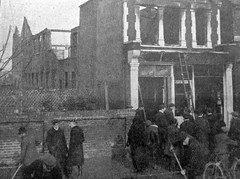
St Ann’s Road
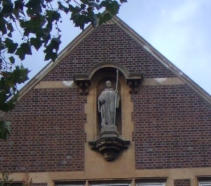
St Bernard’s School
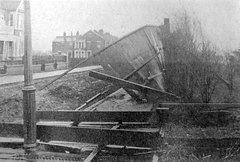
Violent Storms 1910
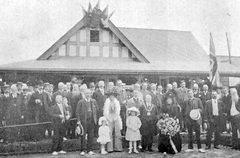
Southend Bowls Club
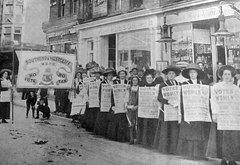
Coronation Celebrations
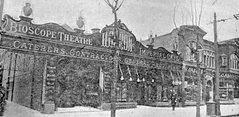
Garons Imperial Bioscope
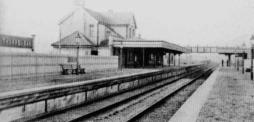
Thorpe Bay Railway Station
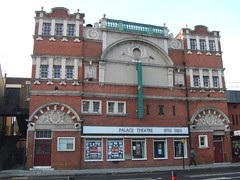
Palace Theatre
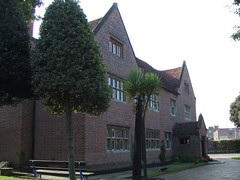
Porters

Westborough Schools
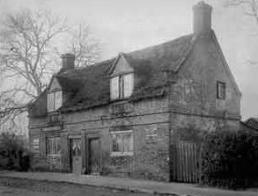
Post Office Southchurch
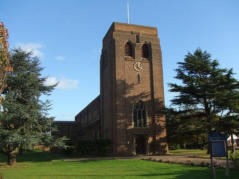
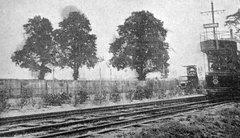
St Augustine’s Church
Tram Boulevard
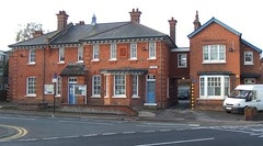
Westcliff Police Station
1919
July. Peace celebrations. Visit of HM Grand Fleet.
Baum’s Furriers opens in London Road, Westcliff.
Star
rises
in
the
West.
In
the
age
of
the
silent
movie,
new
cinemas
started
to
spring
up
around
Southend.
The
Star
opened
in
1919
in
West
Street
next
door
to
the
Blue
Boar
pub.
The
building
remained
in
place
into
the
1990s
but
survived
this
long
under
new
usage
such as a boxing club. The building today has gone, absorbed into the development that brought the Blue Boar back to life.
The
Empire
closes.
On
Alexandra
Street
the
Empire
Theatre
was
finally
closing
its
doors
under
the
present
title
that
is,
but
would
soon
reopen
as
the
Rivoli
Picture
House,
the
owner
at
the
time
was
the
Great
Rameses
a
magician
of
his
time
who
appeared
around
the country performing his act, then ploughing his fortune into the Empire Theatre.
Belfairs
Park.
270
acres
of
woodland
and
meadows
adjoining
the
Nature
Reserve
and
an
18
hole
golf
course,
arguable
the
most
beautiful of the borough's parks was purchased at a cost of £20,000 in 1919 by the council.
United
at
the
Kursaal.
Southend
United
take
up
home
at
the
Kursaal
after
the
Great
War.
There
could
not
be
many
league
clubs
with
a water chute as a backdrop to their games.
Queen Mary's Royal Naval Hospital closes.
The
Aussie's
are
in
town.
Essex
County
cricket
entertained
an
eleven
of
the
Australian
Imperial
Force
at
Southchurch
Park
in
August
1919, the visitors winning by 309 runs.
New
Politics.
Southend
gained
a
new
political
party
this
year.
The
Labour
Party
established
itself
within
the
town,
notoriously
known
for its conservative leanings. By the war there was a membership of around 891.
1918
Southend Corporation takes ownership of The Shrubbery.
The Constitutional Club (Southend-on-Sea) Ltd was formed.
Garrison
grows.
Shoebury
Garrison
was
growing
rapidly
in
strength
and
by
1918
the
complement
of
troops
included
17
officers,
341
men and 80 civilian staff.
Blockships
assemble.
In
April
1918
an
impressive
sight
assembled
in
the
Estuary
just
off
the
Nore
as
block
ships
gathered
in
readiness.
They
went
out
to
block
the
Bruges
Canal
at
Zeebrugge,
this
mouth
being
the
main
exit
point
to
the
North
Sea
for
German
submarines.
11th November. World War I ends.
End
of
the
War.
The
cessation
of
hostilities
of
the
First
World
War
was
hailed
through
a
siren
from
the
top
of
the
gasworks
in
Eastern
Esplanade
in
November
1918.
The
Mayor
of
the
town,
Joseph
Francis,
who
remained
Mayor
for
the
duration
of
the
war
was
the
person to be granted Freedom of the Borough for his services to Southend.
War
hits
the
ranges.
Although
the
Garrison
escaped
unscathed
from
the
attacks
during
the
Great
War
the
worst
event
occurred
in
1918
when
a
fire
was
left
uncontrolled
on
the
New
Ranges.
Flames
spread
to
the
ammunition
dumps
nearby
and
for
the
next
24
hours
a
cacophony
of
explosions
could
seen
and
heard.
The
whole
of
the
area
was
evacuated,
and
the
Kursaal
was
called
upon
as
an
evacuation centre. The cost 1 man died along with a few horses and £3 million worth of equipment.
York
Road
Market
built.
With
the
war
at
an
end
a
number
of
troops
returning
to
the
town
were
jobless
and
unable
to
support
there
families.
The
town's
council
put
steps
in
place
to
build
a
market
just
off
the
High
Street
to
enable
the
veteran's
to
not
only
find
work
but also for their families to buy cheap food and products, York Road Market was born.
Southend's
newest
MP.
Rupert
Guinness
Lord
Elvedon,
became
Southend's
newest
MP
after
the
war.
starting
a
family
legacy
that
would
last
until
1997.
Successive
MP's
in
the
same
or
similar
seat
were
related
to
the
Guinness
clan
in
some
way.
Further
this
election
year
would
see
suffrage
taking
its
course
and
women
over
the
age
of
30
were
allowed
to
vote.
It
wasn't
until
1924
that
women
gained equal age voting at 18.
1917
Health
scare.
Southend
had
a
worrying
outbreak
of
Cerebro-spinal
meningitis
(spotted
fever)
in
the
spring
of
1917.
With
nine
cases
reported the town was being monitored to prevent a wider outbreak.
Empire
gets
some
magic.
The
Empire
Theatre
in
Alexandra
Street
gained
an
unusual
financial
backer
this
year
in
the
form
of
Albert
Marchinsky
(The
Great
Rameses).
After
years
of
touring
the
music
halls
he
decided
to
plough
some
of
his
fortune
into
this
theatre.
The
venture
did
not
last
and
money
poured
out
as
fast
as
he
was
putting
it
in
forcing
him
to
go
back
on
tour,
to
recoup
some
of
his
fortune.
He
later
in
1930
returned
to
the
town
and
underwent
an
operation
at
the
Victoria
Hospital
in
Warrior
Square
where
he
died
at the age of 54.
Prittlewell
Priory
sold.
Mr
R.
A.
Jones
purchased
from
Capt
Scratton,
son
of
the
late
Mr
Edward
Scratton,
Prittlewell
Priory
and
22
acres,
and
that
he
negotiated
a
further
six
acres.
On
completion
he
donated
the
lot
to
the
town
as
a
public
park.
It
was
only
three
years
earlier
that
Mr
Jones
presented
a
recreation
ground
for
school
children,
which
cost
him
£9,000.
Mr
R.
A.
Jones
at
the
time
said
"I
think
it
is
a
sin
for
a
man
to
die
rich,
it
is
a
great
privilege
to
me
to
be
able
to
do
this,
for
I
believe
strongly
in
facilities
for
recreation.
There
will
now
be
no
need
for
such
an
out
of
the
way
and
costly
park
as
Belfairs.
Prittlewell,
with
its
historic
and
old-
world
associations,
its
beautiful
trees
and
lakes,
and
its
nearness
to
the
centre
of
town,
is
an
ideal
place.
Part
of
the
building
would
be
suitable
for
a
museum,
and
there
would
also
be
refreshment
room
accommodation,
while
the
grounds
would
provide
facilities
for
cricket,
football,
tennis,
hockey
and
other
sports.
I
propose
that
the
name
of
the
park
should
be
Priory
Park."
A
condition
of
the
purchase
by
R.
A.
Jones
is
that
the
bridge
at
the
foot
of
Prittlewell
Hill
should
be
widened,
as
he
thought
this
spot
as
a
'death-trap'.
He also proposed to place massive iron gates at the entrance to the new park.
The
Royal
visit.
Southend
was
not
only
on
the
front
line
as
far
home
land
attacks,
but
also
provided
a
vital
service
to
our
forces
by
providing
hospitals.
Commandeered
hotels
the
Palace
and
Overcliff
as
well
as
the
Glen
on
Southchurch
Avenue
provided
excellent
sizeable
accommodation.
The
most
prominent
was
the
Queen
Mary
Military
Hospital
(Palace)
which
on
11th
July
1917
would
be
honoured
with
a
visit
from
HRH
Princess
Mary,
her
visit
was
entitled
to
receive
gifts,
but
of
course
these
would
be
passed
on
to
the
troops
fighting
on
the
front,
or
to
assist
the
war
effort
generally.
She
came
to
Southend,
via
train
from
Liverpool
Street,
dressed
in
pale
pink
and
blue,
and
toured
the
town
by
motor
car,
which
in
times
of
hardness
was
well
turned
out
and
all
the
roads
on
the
tour
decorated
to
welcome
the
Princess
-
Hamlet
Court
Road
looked
particularly
good
-
her
car
also
included
the
Duchess
of
Portland
and
the
Mayor
-
a
string
of
cars
followed
carry
a
variety
of
dignitaries.
Arriving
at
the
Bandstand
the
Princess
was
presented
with
a
bouquet
by
Winifred
Robertson
from
Chalkwell
School.
Children
representing
the
other
schools
were
on
hand
to
curtsey.
The
Royal
party
then
toured
the
hospital
the
Princess
going
up
the
grand
stairway
and
into
the
wards
where
her
presence
was
warmly
welcomed
by patients and staff. Afterwards a tea party in the grounds followed.
Gotha's
attack.
Southend
suffered
the
worst
aerial
bomb
attack
of
the
war
on
12th
August
1917.
Gotha
Bombers
created
massive
damage to Central Southend causing the deaths of thirty two people, many of them children, and 43 were seriously wounded.
Milk
deliveries.
As
the
war
raged
and
so
young
men
were
deployed
to
battle,
daily
home
routines
needed
to
be
taken
up
by
those
who
remained
behind,
Howard
Dairies
based
in
London
Road
would
distribute
its
milk
with
the
aid
of
women
and
children
running
carts
through the streets and dispensing the milk.
Property
prices
slump.
With
the
war
raging
on
and
Southend
being
in
the
line
of
danger
from
attack
by
the
German
Zeppelins
and
Gothas.
It
was
no
surprise
to
see
properties
right
across
Southend
and
Westcliff
were
falling.
Costing
around
£750
to
build
some
now
were
being
picked
up
by
speculators
for
£500,
basing
there
acumen
on
when
peace
arrives
the
property
market
will
be
more
buoyant
and people will want to return to the seaside to live. They didn't have too long to wait.
1916
March. Zepplin L15 crashes into the estuary east of the Pier.
King
visits
New
Ranges.
On
4th
April
1916
George
V
visited
the
New
Ranges
to
witness
the
testing
of
a
variety
of
equipment.
He
took
lunch
at
the
Officers'
Mess
and
inspected
the
school
of
gunnery.
Local
children
lined
Motts
Meadow
just
off
the
High
Street
to
watch
the king and his entourage pass by.
HMS
Marlborough
saw
action
in
the
most
infamous
of
all
sea
conflicts
during
World
War
One,
the
Battle
of
Jutland
on
31st
May
1916.
This
grand
warship
would
have
a
few
Southend
sailors
on
board;
the
original
white
ensign
of
HMS
Marlborough
is
today
flying
inside St John the Baptist Church in Southend.
RFC
Land.
Southend
Aerodrome
during
the
First
World
War
played
an
important
part
in
the
defence
of
the
country.
On
4th
June
1916,
the
forerunner
to
the
Royal
Air
Force,
the
Royal
Flying
Corps
took
control
of
the
airfield.
The
role
was
instrumental
in
attacking
the many Zeppelins that attempted to drop bombs on the town.
Baseball.
This
US
sport
captivated
the
Southend
public
during
1916
with
4
matches
played
between
Canadian
and
American
teams.
All
the
games
were
very
well
attended
and
drew
attention
away
from
the
misery
of
war.
The
baseball
players
were
invariably
drafted
in
from
the
military
that
were
supporting
Britain
in
the
conflict
at
the
time.
Although
Canada
did
have
its
fair
share
of
success
during
the four series' of games, the US became outright Southend Baseball Champions for 1916.
The
Kursaal
Zoo
opens.
Over
it's
many
transformations
since
it
opened
in
1901,
the
Kursaal
on
10th
June
1916
opened
a
Zoo
with
around 100 animals put in cages and dens around the grounds.
Panto
time.
“Little
Red
Riding
Hood,”
produced
by
Mr
Bannester
Howard,
at
the
Hippodrome
started
on
Boxing
Day
and
was
considered
to
be
one
of
the
brightest,
most
musical
and
amusing
pantomimes
put
on
stage,
and
the
crowded
houses
were
sufficient
evidence
of
the
public
appreciation.
The
story
of
which
was
rewritten
by
Mr
Fred
Bowyer.
Miss
Molly
O’Shane
was
a
captivating
Red
Riding
Hood,
and
sang
some
clever
songs.
Those
two
clever
young
performers,
Bella
and
Jules
Terry,
were
delightful
as
Jack
and
Jill,
the
two
lovers.
In
Miss
Josey
Leyton
the
producer
has
found
and
ideal
“Boy
Blue
and
Miss
Nora
Neville
was
delightful
as
Miss
Muffet.
Messrs
Harry
Bennet,
and
George
Asquin
kept
the
audience
in
laughter
as
the
two
bad
lads
of
the
village,
and
Mr
Arthur
Lawrence
made
and
emphatic
success
as
Gobblem
the
Wolf,
while
Miss
Doroty
Fitzjerald
was
bright
and
pleasant
as
Fairy
Sunbeam.
Mr Bobby Dillon and Mr Charles Ross had plenty of laughter making opportunities as the wicked Squire and Mother Hubbard.
1915
Southend's
Arms
Crest
and
Supporters.
Formalising
Southend's
stature
George
V
granted
the
Arms
and
Crest
along
with
the
Supporters at the beginning of January 1915. The design is by Mr E. A. Ebblewhite.
Overcliff
Hotel
commandeered.
It
was
not
hard
for
the
businessmen
of
the
town
to
recognise
this
war
demanded
all
to
assist.
One
obvious
area
would
be
the
use
of
large
hotels
as
hospitals.
The
Palace
had
already
been
turned
successfully
into
a
medical
station
for
the
war
wounded.
The
Overcliff
situated
on
the
Leas
in
Westcliff
became
another
target
and
in
January
1915
it
too
took
up
a
war
role
as
a
Red
Cross
Hospital.
It
would
not
take
long
to
turn
the
once
much
loved
holiday
hotel
in
to
the
latest
hospital
of
medical
standards
could
afford
at
the
time;
with
x-ray
suites
and
operating
theatres
at
hand
to
assist
the
war
wounded.
Mr
James
Tabor
headed
the
committee
that
controlled
the
finances
of
the
hospital.
The
Matron
Mrs
Earle
would
extend
a
welcome
to
the
man
visitors
from
the
local
community
that
would
come
into
the
hospital
to
raise
the
morale
of her patients.
New
splash
opens.
Western
Esplanade
saw
an
exciting
development
in
the
shape
of
a
new
Swimming
Pool
opened
on
6th
May.
Built
in
the
style
of
a
Lido
this
popular
attraction
provided
the
solution
for
trippers
when
the
tide
was
out
to
still
swim.
The
pool
survived
into
the
late
60s
when
it
was
formally
closed
and
for
a
brief
time turned into a Dolphinarium.
Peggy
Mount
is
born.
Born
Margaret
Rose
Mount,
was
an
English
actress
of
stage
and
screen.
She
is
perhaps
best
known
for
playing
a
battleaxe
characters,
though
her
real
personality
was
said
to
have
been
far
removed
from
such
roles.
Peggy
Mount
was
born
in
Leigh-on-Sea.
Her
love
of
acting
had
begun
with
the
dramatic
society
of
the
Wesleyan
Chapel
which
she
attended
in
Essex.
She
first
worked
as
a
secretary
and
took
lessons
from a drama tutor, Phyllis Reader, in her spare time.
Westborough
bomb.
May
1915
an
unexploded
bomb
was
discovered
in
the
playground
of
Westborough
School,
the year was blighted with bomb drops from Zeppelins.
Zeppelins
attack
Southend.
First
major
Zeppelin
air
raid
of
WW1,
bombs
fell
on
Southend
and
Westcliff.
It
was
reported
the
shock
of
the
events
made
a
horse
panic
and
bolt
through
the
window
of
Boots
the
Chemist.
On
12th
May
1915
in
response
to
the
raids
two
days
earlier,
there
were
anti
German
riots
in
Southend
and
five
shops
in
the
High
Street
and
Queens
Road,
alleged
to
have
been
German or Austrian owned, were wrecked.
Kursaal
occupied.
With
the
war
raging
it
was
necessary
to
find
emergency
accommodation
for
troops
pouring
into
the
area.
The
Kursaal
was
a
natural
choice
but
only
for
a
short
period
of
time,
the
Kursaal
Gardens
reopened
on
Saturday
23rd
May,
admission
was
1d but free for soldiers and sailors.
Mrs
Agnes
Whitwell.
As
a
result
of
the
bombing
above
Mrs.
Whitwell
became
a
victim
of
the
attack
and
died
at
her
home
in
Ashburnham
Road.
Her
funeral
drew
crowds
to
watch
the
funeral
procession,
and
enraged
the
locals
enough
to
attack
the
homes
and
businesses of German or Austrian association.
Summer Gymkhana. The summer Bank Holiday would see Chalkwell Park host a horse show and gymkhana.
Queen
Mary's
visit.
It
had
been
rumoured
for
several
months
that
a
Royal
visit
was
likely
to
be
made
to
Queen
Mary's
Naval
Hospital
(Palace
Hotel).
On
Wednesday
16th
June
1915,
Queen
Mary
visited
her
hospital.
She
toured
the
wards
made
up
mainly
of
military
patients.
Although
the
visit
was
supposedly
secret,
word
did
get
out
and
several
thousand
residents
assembled
outside
the
hospital.
When
she
had
completed
the
tour
of
the
wards
she
made
her
way
out
to
the
balcony
and
the
waiting
crowd
outside.
The
Queen
stayed for over 2 hours and was most gratified with everything she had seen, and was most pleased with the views across the estuary.



Website Info:

Southend-on-Sea’s No 1 History Website! Documenting The Town & The Townspeople
Now Incorporating The Sea Of Change Website


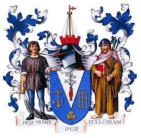
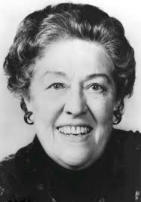
Peggy Mount
Southend’s Arm Crest
SOUTHEND CITY
Chalkwell ▪ Eastwood ▪ Leigh-on-Sea ▪ Prittlewell ▪ Shoeburyness ▪ Southchurch ▪ Thorpe Bay ▪ Westcliff-on-Sea
































































